Launching a boat is an act of faith: you choose a design carefully, build it as well as you can, and maintain it faithfully, but in the end you never know where that boat will go and how the life you’ve given it will play out. So it is, also, with an organized event that gathers boats to sail and row in company.
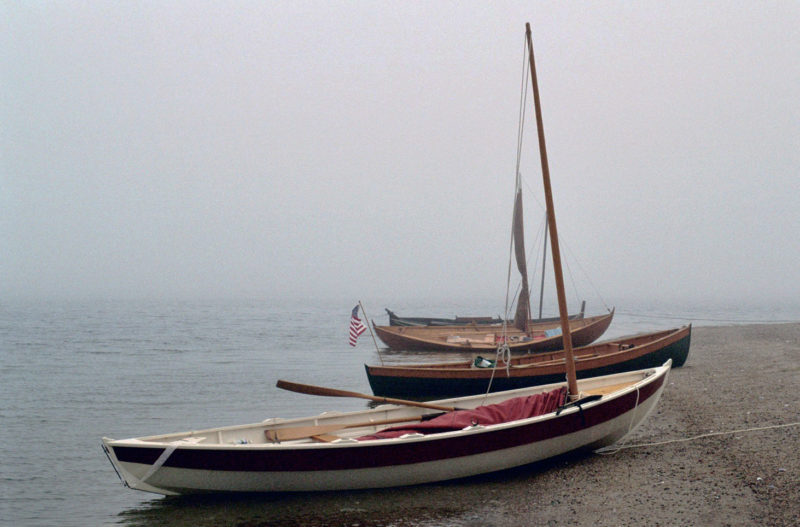 Tom Jackson
Tom JacksonThe Small Reach Regatta started off in 2006 as a very casual gathering of small-craft enthusiasts. These boats—representing about half the fleet—are, front to back, OCARINA, a Joel White-designed, stretched Shearwater owned by Jack and Susan Silverio; PUCK, a Harry Bryan-designed lapstrake plank-on-frame pulling boat owned by the late Bob Yorke and his wife Judith; an Oselver faering on loan to Wade Smith; and LITEN KUHLING, Ben Fuller’s Afjordsfaering on loan to Tom Jackson.
In 2006, I was among a group of small-craft sailors from around Penobscot Bay, Maine, who gathered to launch what became the Small Reach Regatta (SRR), a name reflecting its notion of sailing small boats in the same waters as the wooden racing yachts of the Eggemoggin Reach Regatta, founded in Brooklin in 1985.
A year before that first SRR, I had sailed in Raid Sweden, a week of sail-and-oars racing in the Blekinge Archipelago, which I wrote about in WoodenBoat No. 187. I came back eager to see something like that on our shores. I had big ambitions, but the practicalities of running such an event as volunteers soon became apparent to those of us in that initial group as we faced the down-to-earth realities of local geography and infrastructure.
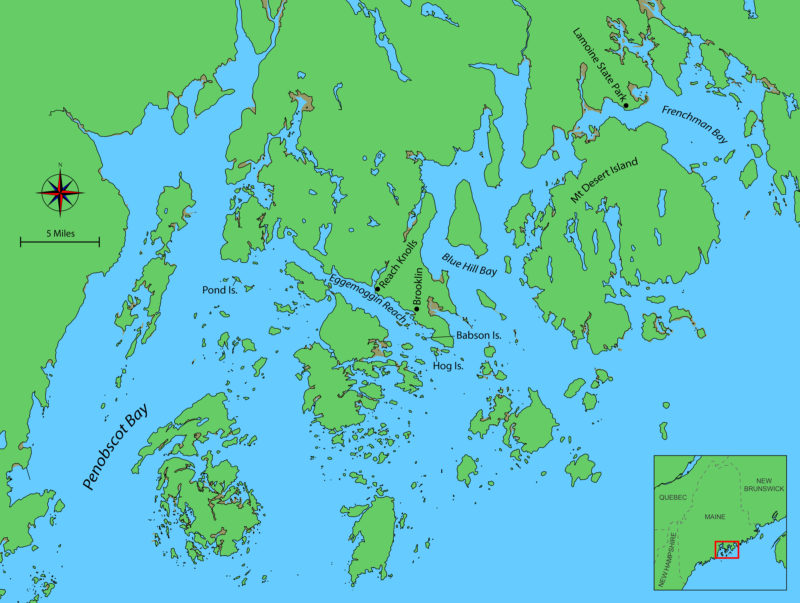 Roger Siebert
Roger Siebert.
We started small. News of our first gathering spread through a local email list, online connections, and word of mouth. In the first year, we had only about eight boats, but even then it was a wildly various fleet, from kayaks to faerings. We had heavy and light boats, plywood and traditional planking, oars-only or sail-and-oars types, and a variety of overall lengths.
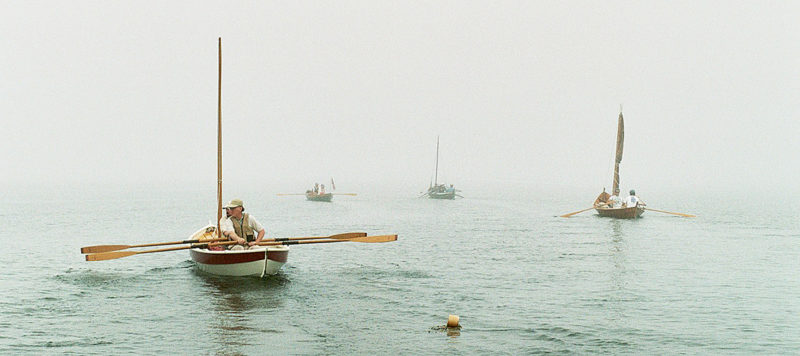 Courtesy of the author
Courtesy of the authorFrom the first year, the Maine coast’s propensity for fog was a continual concern for the SRR. With the possibility for light air and fog, the ability to row and remain self-sufficient was paramount.
We hauled out on a beach on Pond Island in Blue Hill Bay and over lunch talked about what this event could be. No doubt I regaled the group—as I am known to do sometimes—with fresh memories of Raid Sweden. Maine plainly didn’t have the advantages of large and accessible stone buildings maintained by a cruising association. But what it had in common with Sweden was a staggeringly beautiful coastline.
We asked ourselves what such an event would look like in Maine. Four of the people in that discussion—myself; David Wyman, a naval architect from Castine; Ben Fuller, a museum curator and maritime historian from Thomaston; and Jack Silverio, an architect from Lincolnville—remained part of our “core group” of planners for all 15 runnings of the SRR. (After a few years, Paul LaBrie of West Gardiner, and later Steve Brookman of Blue Hill, joined the core group. All of us became associated with the Downeast Chapter of the Traditional Small Craft Association, or TSCA. We quickly settled on limiting the fleet to open boats that can beach readily, with no motors.
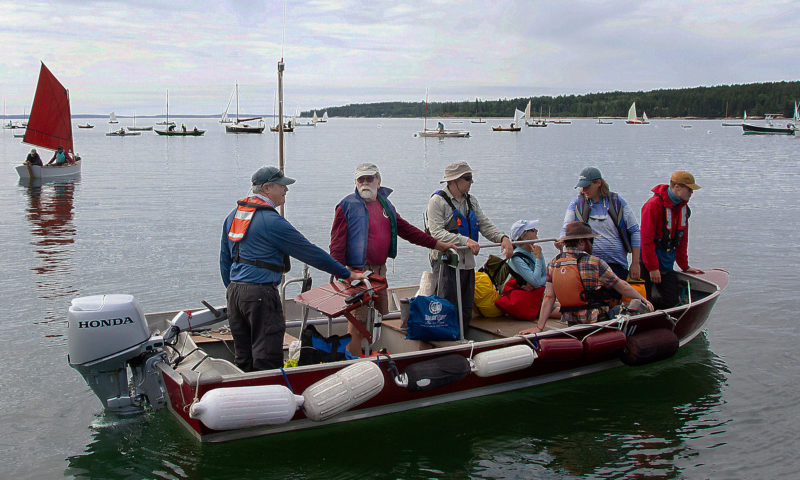 Rosemary Wyman
Rosemary WymanHaving a fleet of chase boats, both for safety under way and to ferry people to and from anchored boats, was an essential part of the SRR. Every year, the Maine Island Trail Association provided the aluminum skiff seen here and volunteer skippers to take part. They were among a stalwart group of regular chase-boat drivers, most of whom used their own powerboats.
From the first, it became clear that Maine presented challenges to fleet sailing. The coastline has abundant charms, but large public facilities are not among them. One key asset was the Maine Island Trail Association (MITA), which manages the first water trail of its type in the United States and has long been an essential resource for a small-craft sailors on this coastline. Its sites are rustic, though, and can handle only small groups with no-footprint camping. Some conservation islands can handle large groups for day visits, but often only by permission. Some launching ramps in the area can be charitably described as “challenging.”
Any idea of a one-way, point-to-point “raid” with a large fleet camping through the islands fell apart on the issues of fresh-water availability and toilet facilities, without even considering such things as lodging, boat launching, or trailer parking.
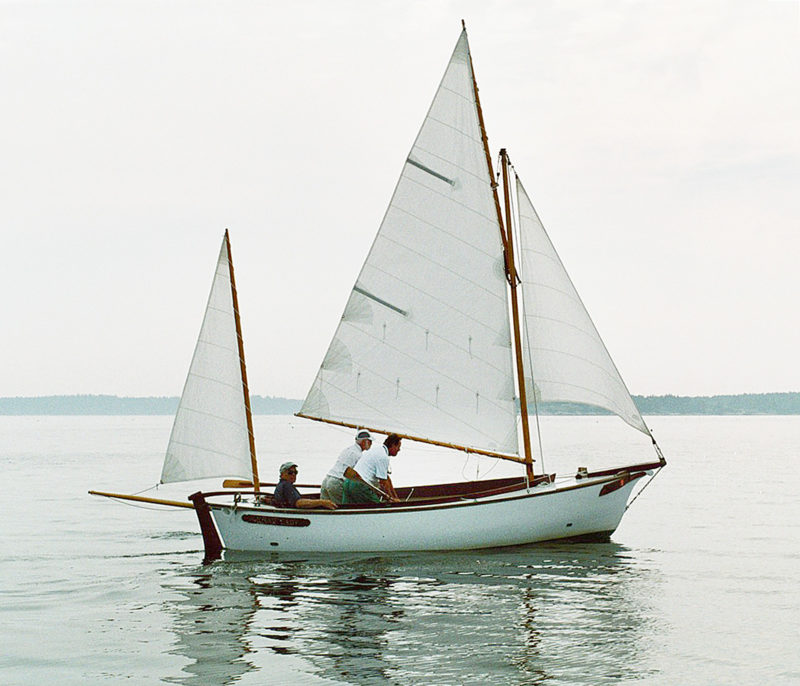 Courtesy of the author
Courtesy of the authorDavid Wyman designed and built his own yawl, ISLAND LADY. He became one of four people—the others being Tom Jackson, Ben Fuller, and Jack Silverio—from the first year who remained part of the SRR’s core planning group for 15 events over 16 years.
The European “raid” was dedicated to racing. From the start, our group was not—not in the least. I found that to be an initial disappointment, but I came to be overwhelmingly grateful that we didn’t have to deal with the added complication of racing logistics.
We quickly realized that sailing a projected fleet of 20 to 30 boats in our area would work best by finding a base camp. From there, we could set daysailing courses based on weather.
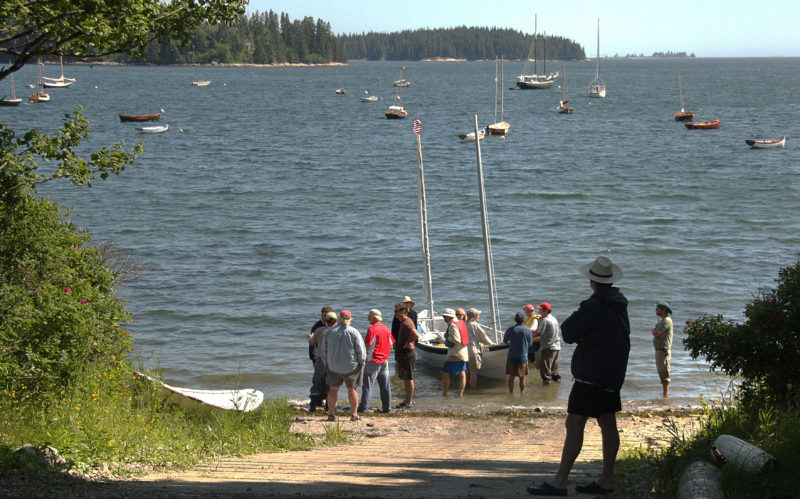 Rosemary Wyman
Rosemary WymanVolunteerism became a hallmark of the SRR, especially when boats had to be carried over rocky shores to soft ground.
We started out at WoodenBoat Publication’s grounds in Brooklin, although the SRR was never a WoodenBoat event. In 2010, we moved to the more commodious Lamoine State Park, which fronts Frenchman Bay near Mount Desert Island, home of the popular Acadia National Park. The state park was accommodating, but its launching ramp was shallow and the waterfront had only a narrow band of anchoring depth. After three years there, we moved for two more years to Hog Island Audubon Camp, a turn-of-the-last-century rustic inn on a 330-acre island in Muscongus Bay, west of Penobscot Bay. Audubon has owned the preserve, which is otherwise uninhabited, since the 1930s, and its trails and beaches are a delight. We had the entire island to ourselves for the SRR, with lodging in tents and in dormitories, a central dining facility, and a classic large central meeting room with a stone fireplace. One thing we learned from Hog Island, however, is that logistics for an island are exponentially more complicated than for the mainland.
Casting around for other likely locations, we found a great many that dialed exactly the right combination of excellent sailing waters, a decent launching ramp, a good anchorage, and ample campground capacity for a small group. Few could accommodate what had become a 40- or 50-boat fleet with tenting ashore. When we learned that a new private campground in Brooklin called Ocean Camping at Reach Knolls had opened and could accept our entire group, we jumped at the opportunity to return to our roots.
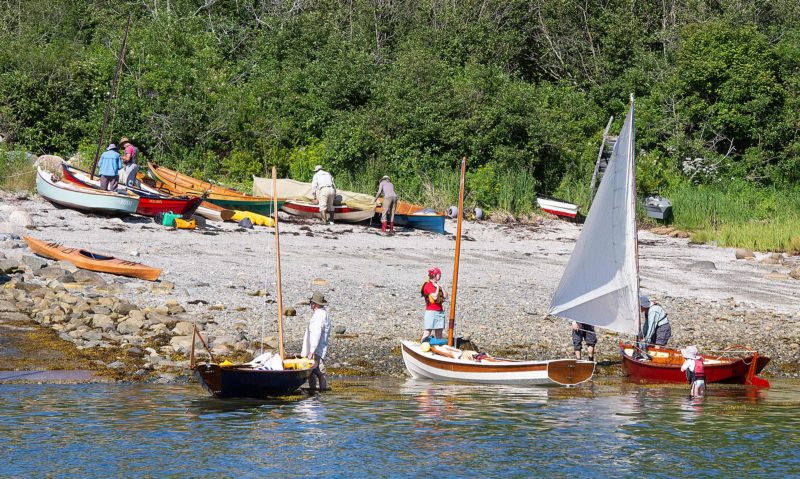 Courtesy of the author
Courtesy of the authorLaunching ramps can be challenging in some areas of Maine. At Atlantic Boat on Herrick Bay in Brooklin, a ramp that is good on most tides, with an adjacent beach, proved to be among several compelling reasons to keep the SRR in one place.
And there we settled. For the SRR days, we reserved the entire campground, which had room for growth. We also drew on the generosity of Atlantic Boat Company, a Brooklin boatyard with quite a decent launching ramp, plenty of trailer parking, a small beach for light boats, and an ample anchorage in Herrick Bay, which is at the threshold of Blue Hill Bay, Jericho Bay and Eggemoggin Reach, all of which we sailed.
Over the years, the fleet grew. In 2021, our 15th SRR and the one that we decided would be the last, we all gasped a bit when we initially had applications for 125 boats. But we knew that number would fall, as it always had before. The fleet, still the largest ever, finally settled out at 83 boats.
As the 2021 SRR came and went, people in the fleet and friends around town immediately started asking why, when it seemed so popular and successful, would we stop?
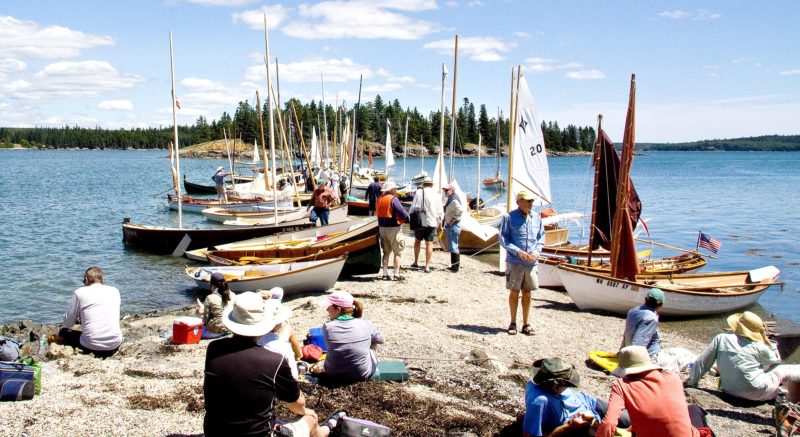 Rosemary Wyman
Rosemary WymanHaulout areas for lunch had to be chosen carefully. A sandspit at Sheldrake Island east of Frenchman Bay proved to be an ideal daysail from Lamoine State Park—but had to be vacated quickly on a rising tide.
First, we of the core group were all volunteers, and we were all 16 years older than we were when we started (counting 15 SRRs and a year off for Covid-19). Most of us were ready to move on, maybe to smaller sailing adventures that would liberate us from the need for administration. We were always strictly egalitarian, and we all paid the same entry fees, camping rates, and meal prices as everybody else. It was all for one, and one for all. But we didn’t see a rising cadre of new volunteers in the area. Many of our participants were from New England but they also came from as far south as Virginia and Florida and as far west as Michigan and Wisconsin. Those who seemed eager to volunteer seemed too far away. We were meeting every month, and even for some of us living in the area it was an hour’s drive to do so.
We were also nearing the capacity limits of the campground and the anchorage. None of us could envision going back to searching farther afield, and in any case we had already looked high and low. Hitting growth targets and setting records was never our “thing,” but we were always reluctant to impose limits on the fleet, knowing that with first-come, first-served protocols or some sort of lottery, some regular participants who had formed solid friendships in the group would inevitably have to be turned away. Either that or we wouldn’t be able to make room for new participants who helped to keep the event fresh for everyone.
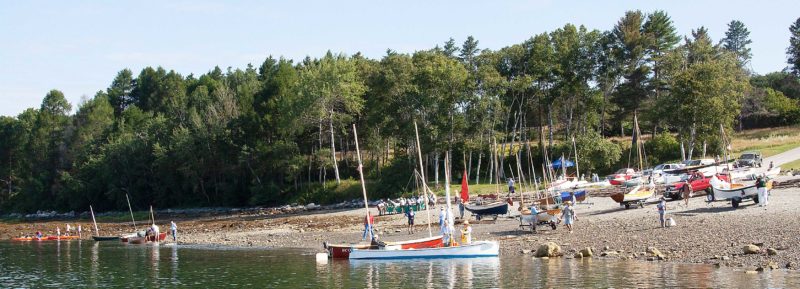 Rosemary Wyman
Rosemary WymanLamoine State Park, which overlooks Mount Desert Island, home of Acadia National Park, was home to the SRR from 2010 to 2012. The park had excellent facilities but a challenging launching ramp and only a narrow band of anchoring depth. One of its amenities was a large field where boats could be stored, allowing some 40 owners to do quick presentations about their boats.
We decided to end it on a high note. We set 2020 for the final year, but of course the pandemic scrambled that plan. We decided to hold the last event over until Covid-19 restrictions lifted, whenever that would be. We delayed the 2021 “go” or “no-go” decision as long as we could, then decided in late May to proceed for July 7–11.
As always, we scheduled three days of sailing. Under a cloudy sky on Thursday, we had good winds and no rain; many boats were single-reefed and some double-reefed. On Saturday, we had light air but ample sunshine.
On Friday, however, Tropical Storm Elsa brought a day and night of torrential rain and strong winds. We all spent much of the morning battening down our boats, spreading farther apart in the anchorage, and letting out more scope. That afternoon, Ben Fuller arranged a group tour of the fine small-craft collections at Penobscot Marine Museum in Searsport, where he had been the curator, and one of our participants, Gardner Pickering, led a tour of the CNC boat kit operations at his workplace, Hewes & Company in Blue Hill. Our longstanding caterer, Frank Bianco of Brooklin, gamely made the grill dinner work despite the downpour—even though most of us kept our sea boots and foul-weather gear on for dinner, seeing that the water that was ankle-deep even under the big tent. Despite the lack of sailing, the sodden dinner grounds, and the soggy campsites we had to settle into, I heard not a single complaint.
 Rosemary Wyman
Rosemary WymanLunchtime haulouts, a regular feature for the SRR, provided an opportunity for comparing boats in close quarters and they were a way to keep the fleet together.
Over the years, we had seen just about every kind of weather that summer in Penobscot Bay can bring—dense fog, sparkling clear days, flat calm, fine breezes, strong winds, thunderstorms. Everyone has favorite stories from the SRR, and one of mine came just after my crew and I landed in an exceptionally dense fog on a fine beach at Babson Island off Eggemoggin Reach. Willits Ansel, a shipwright I had written about and a man not given to using technology beyond a chart and compass, landed near us. He got his sailing dory squared away and then walked up to join us. “Tom,” he called out, “can you tell me where we were?” I could not.
At first, we had the idea that a group of boats could gather without much coordination. Every skipper was his or her own master, we thought, and we believed we could simply sail in company more or less as equals. We learned very quickly, however—in the second year, I think—that not all skippers were experienced with tidal currents, not all had ventured out or been caught out in high winds. Not all had anchored just off a rocky lee shoreline with gales predicted. Some didn’t know their reefing systems well, and a few not at all. Some had not much more than a paper clip for an anchor and a rubber band for a rode. We learned to set conservative routes. We sometimes chose rowing over sailing and stayed near shore. We were reminded that in the fog the sound of lobsterboat engines somewhere nearby can be extremely disconcerting to the uninitiated—and even to old-timers.
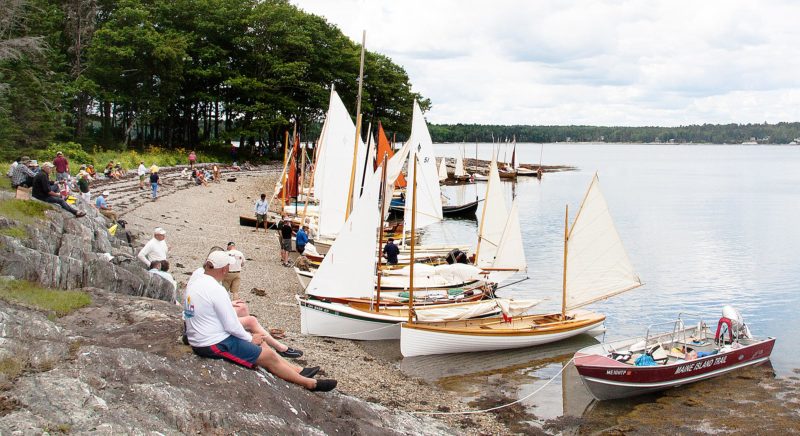 Rosemary Wyman
Rosemary WymanBean Island in Frenchman Bay was a prime example of a conservancy island—one of many scenic islands in Maine that allow zero-footprint day visits but no camping—that gave SRR participants a personal connection to the Maine coastline.
We learned that when you invite people to sail in a scheduled event, you feel a great deal of responsibility not only for their safety but also for the quality of their experience.
We established a very effective chase fleet under David Wyman’s leadership. He recruited numerous powerboat owners of his acquaintance to join in over the years. He brought a boat of his own design to lead them; I took to calling him the admiral of the fleet. Sometimes he turned his boat over to others so he could sail a while. His friend Denzel Hankinson came year after year with his “a-bit-funky” but reliable power cruiser from Massachusetts; Grigg Mullens brought his Chesapeake Bay draketail from Virginia; Mark Ober drove his Pulsifer Hampton boat a long ways over from Sorrento on Frenchman Bay; every year MITA provided one of its capacious aluminum skiffs with a very game crew of volunteers. By the final running, the chase-boat drivers knew each other—and one another’s skills—very well. It was difficult to think of finding replacements for them, should any bow out. The chase boats ferried crews out to anchored boats and could give a tow if necessary. But they were not search-and-rescue professionals; in a really serious emergency—which we never had—their primary task would have been to render whatever assistance they could and hail the U.S. Coast Guard, whom we always notified of the event. In only one or two instances, a chase boat took someone ashore for a medical issue unrelated to sailing.
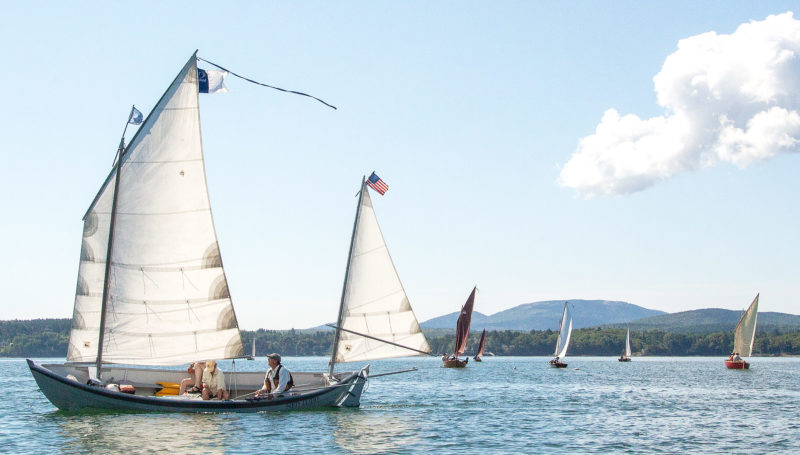 Rosemary Wyman
Rosemary WymanAbove all, the SRR was about getting on the water in a variety of boats and rigs—although always with a healthy contingent of Iain Oughtred–designed Caledonia yawls.
We were serious about the safety gear we required participants to have. We had three capsizes over the years. Only one, when a boat turned turtle in the fog, was concerning. Another was towed into shallow water after the skipper learned he could not control water ingress through the top of his centerboard trunk. We didn’t require GPS, but we highly recommended it, and many who experienced the strange psychology of dense fog decided on their own to add a handheld GPS to their inventory. We always required VHF radios, set to channel 68 and close at hand, so that any problem could be reported to the chase leader. We had paperwork on everyone, skipper and crew.
We also advised having two anchors, one heavy and one light. People in the early days often showed up with light Danforths; by our 15th running, very few were asking anymore why we advised heavier gear, and most slept soundly knowing their boats were well anchored for the nights when they could hear the wind howling through the treetops in the campground. The morning after the storm in our final year, we didn’t have any serious problems in the anchorage. But even then, a few more skippers, especially solo cruisers, may have thought about high-grading their ground tackle.
We learned that some boats were not set up well for reefing in strong winds—and it did blow sometimes. Chase-fleet boats often stood by struggling boats to make sure they were safe and to extend advice or help. They could tow if necessary, but such times were rare. We expected people to want to be self-sufficient. We also asked skippers to have a plan for recovery after a capsize and to communicate the plan to their crews.
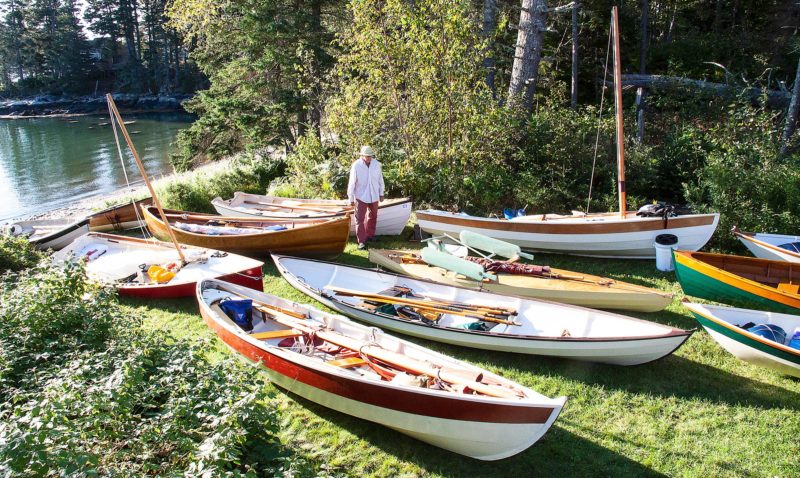 Rosemary Wyman
Rosemary WymanAt the Hog Island Audubon Camp in Muscongus Bay in 2013 and 2014, logistics had to be adjusted to the realities of getting people, boats, and gear to an island. The hand-carry boats had to be closely packed in.
But something else happened, too: sailors began to learn from each other. Questions came up casually on the beach or over dinner or around a campfire, and solutions and ideas were liberally shared by all. In the course of this give-and-take, a lot of friendships were made, and sailors came to look forward to reuniting with the group as much as they looked forward to the actual sailing, and maybe more. Volunteerism started in the first year, when everybody needed help carrying boats down a very rocky launching ramp. Everybody chipped in. All for one and one for all. That ethic extended throughout the SRR, and the group amplified it in ways of their own.
By the end of the last SRR, a lot of education had taken place. Some of it was formalized; we did sessions on VHF use for those not familiar, Ben Fuller did a capsize recovery demonstration, we reviewed safety gear ahead of launching, we did a few presentations about emergency equipment. As we went on, fewer sessions were needed, and most of the learning happened person-to-person. Over the years, we all noticed an overall gain in competency with things such as anchoring, reefing, navigating, radio usage, capsize preparedness, and even sail trim. There were fewer and fewer instances of boats struggling on very windy days. People who brought their boats to the SRR often went home better mariners than they were when they came.
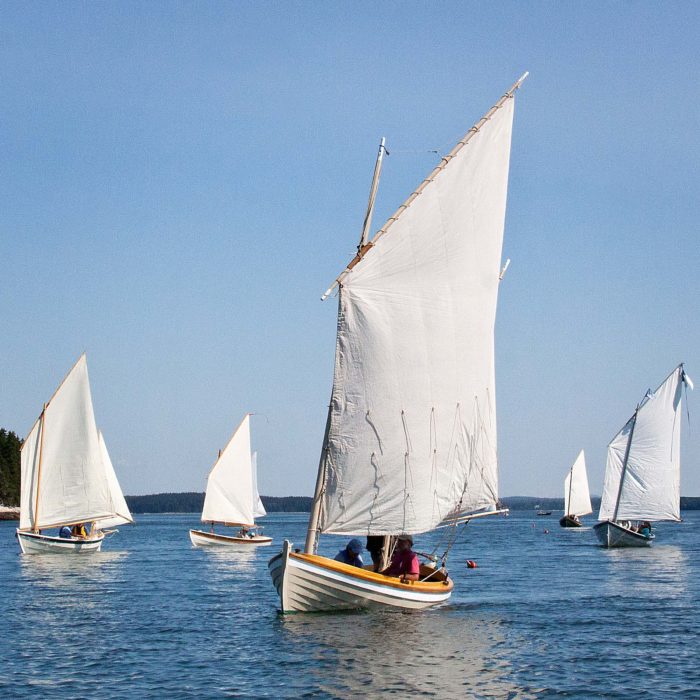 Rosemary Wyman
Rosemary WymanThe author borrowed Ben Fuller’s Afjordsfaering for the first two SRRs, ending in 2008, when he launched his No Mans Land boat, FAR & AWAY, at center.
At the end, participants starting asking how we could keep it going, maybe by moving to a new state. My stock reply was this: “What do you need us for?” Our fondest hope was that more small-craft gatherings would emerge, that the idea would proliferate. All you need is good people, volunteers who bring individual strengths to the table.
One thing we learned was to simplify. In the early years, we had one four-wheel-drive pickup truck launching all the boats, which arguably may have been necessary at a rocky launching ramp. But that persisted longer than it should have; it dawned on us that at other ramps people could launch their own boats—after all, what did they do when we weren’t around? We stopped providing custom laminated charts, which took hours to produce, because charts were readily available. After trying to arrange vegetarian and special-needs menus, we gave up and said that if the menus didn’t appeal, people could arrange their own meals to suit their needs. We considered not doing meals at all, but my wife, Corinne Ricciardi, reminded me that if we did, it would be a vacation for me but not for her. We printed tickets for meals early on, but we ended up just taping a laminated list to a tent post so people could remind themselves of what they had paid for. Simplifying probably gave us the energy to go on through the 15th running instead of ending after the 10th, which some had been ready to do but stayed on, I think, mostly out of loyalty to the group.
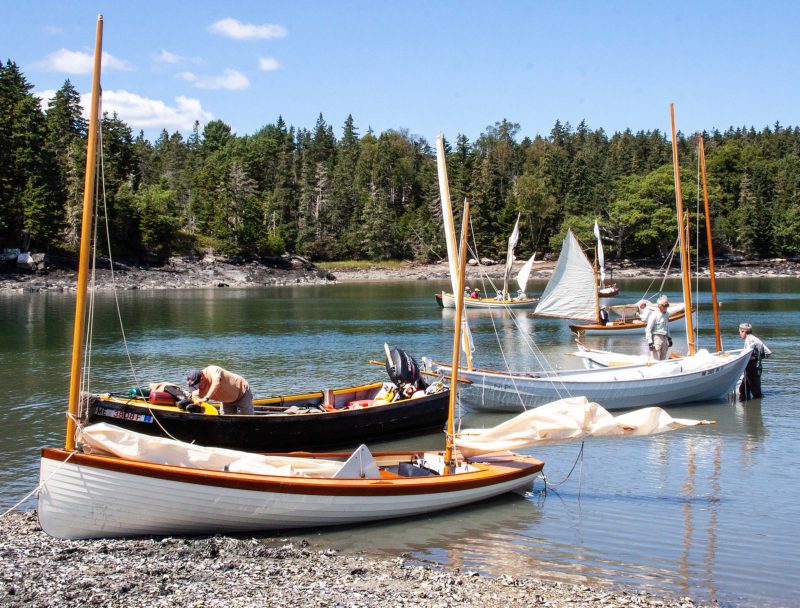 Rosemary Wyman
Rosemary WymanWith what appeared to be a sandspit actually turning out to be a mussel shoal, some boats remained at anchor and rafted up for lunch during one of the Muscongus Bay sailing days in 2013.
Other locations would have different problems, with corresponding solutions. Some problems would be uniform. We were loosely organized and independent at first, but we reorganized under the umbrella of the Downeast TSCA after we learned that if we did we would have insurance through the national TSCA. We thought about insuring also against, say, a hurricane warning that would force cancellation but leave us with fixed-costs and people asking for refunds. Instead, careful stewardship of resources, as taken up by Paul LaBrie, created a cash reserve that allowed us to essentially self-insure. We sold T-shirts with a logo by the artist Sam Manning; he and his wife, Susan, were regular participants. We ended up in such good financial shape that after the final SRR we donated $5,000 each to the Maine Island Trail Association, the Penobscot Marine Museum, and the TSCA’s John Gardner Fund scholarships.
Very often these days, events seem to take on an extreme-sports tenor, as if nothing counts unless you get dramatic GoPro video or Red Bull sponsorship. At the SRR, we were unwilling to put people at risk by inviting them to do more than they were comfortable with. We always welcomed families, and a few times we had three generations. We granted scholarships to youth programs, most memorably to Boston Family Boatbuilding. Having inexperienced people join the fleet reaffirmed the need to choose conservative routes and sailing conditions.
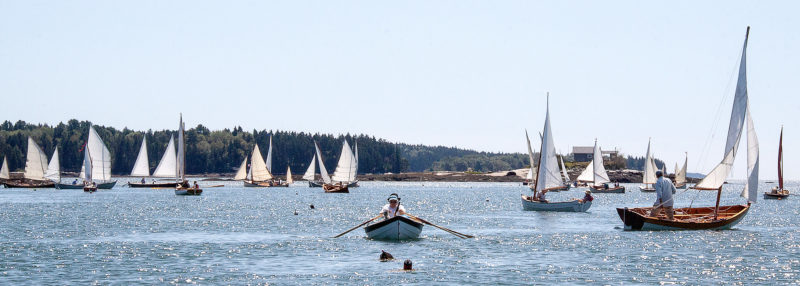 Rosemary Wyman
Rosemary WymanAlthough sailing craft were predominant, the SRR always had room for oars-only boats, often eight or 10 of them—and the rowing boats were often first to the haulout destination. The event never had absolute rules on minimum or maximum length, recognizing that in the right hands a small boat could be taken just about anywhere. The principle rules were the ability to beach and relaunch without assistance, the ability to row long distances, no cabin structures, and no motors of any kind.
But as we grew, veteran participants started looking for their own adventures. Some sailed independently before or after the SRR. My own favorite experience was sailing solo from Brooklin to Muscongus Bay—four days, and I never got off the boat. After that much time self-contained, I arrived at Hog Island ready for socializing, great daysailing, good food, comfort ashore with friends, and rounds of music in the central hall. Then I sailed two days home. That closeness with nature, depending entirely on your wits to judge wind and weather and decide courses, is an adventure in its own right. It’s better than day racing.
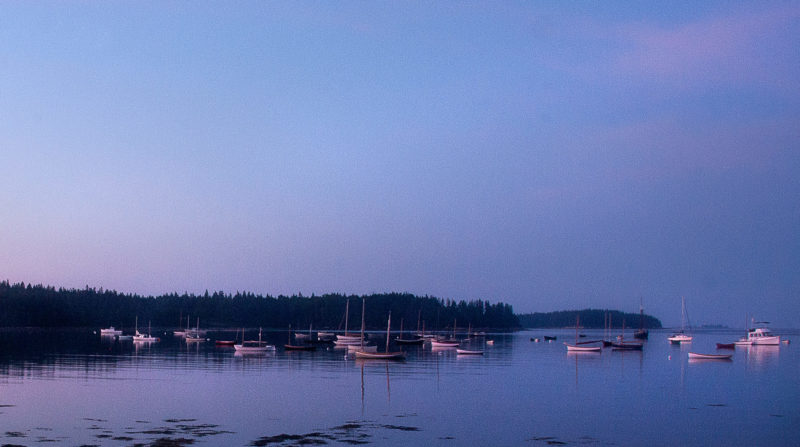 Rosemary Wyman
Rosemary WymanIn the first years, 2006–09, the SRR started from the WoodenBoat School in Brooklin, seen here in the early morning light with the fleet intermingled with the school’s boats and visitors. Many of the SRR participants were school alumni.
We of the Downeast TSCA sail in company six or seven times a year, a commitment to getting out on Maine’s coastlines, rivers, and inland lakes that pandemic isolation only reaffirmed. More SRR participants, too, started to sail in company on the Maine Island Trail and elsewhere. Their experiences and friendships deepened as they found their own adventures. I hope they launch events with no idea where they’ll end up, keeping the spirit of the SRR alive and introducing others to what I view as a way of life.
To me, and I think to all of us, that’s entirely what the point of it all was.![]()
Tom Jackson is senior editor of WoodenBoat magazine. He is a native of the Pacific Northwest but has lived 24 years in Brooklin, Maine, where he sails a 17′ 8″ No Mans Land boat and rows a Gloucester Light Dory, both of his own construction, and paddles an 18′ Old Town wood-and-canvas guide canoe.
If you have an interesting story to tell about your adventures with a small boat, please email us a brief outline and a few photos.

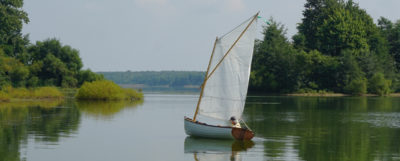
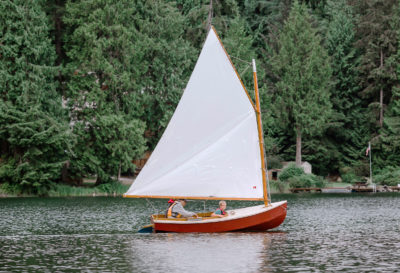
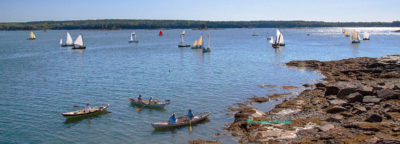
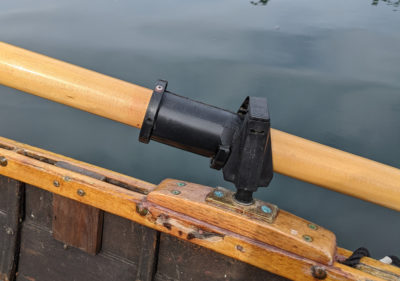
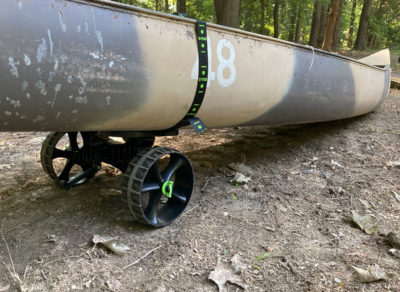
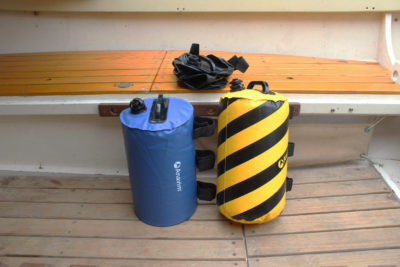
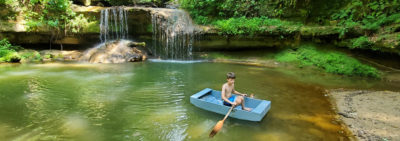
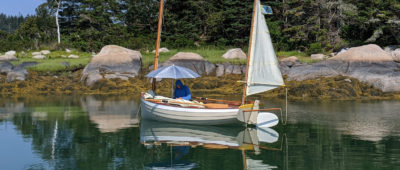
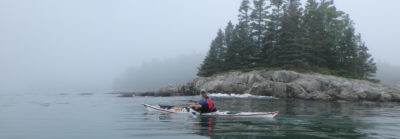

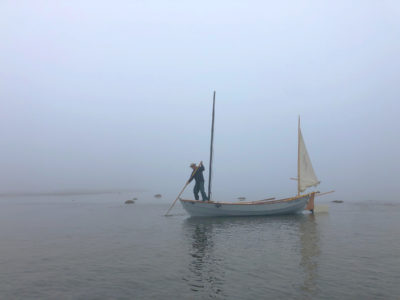
We who have participated in the Small Reach Regatta are grateful to the originators and all of the organizers from the Downeast Chapter of TSCA of this event. It brought out in each of us the ideal opportunity to sail in company with so many like-minded friends. I am glad I got to go more than once.
Hear, hear!
SRR was a summer highlight, right from the first exploratory sail/row. And it became the very best of Amherst (MA) Regional High School Class of ’61 reunions for David Wyman (ME), Denzel Hankinson (MA), the late Steve Brown (ME) and me (WA). The kinda funky chase boat, ERMA, replete with blue carpet and PVC everything else and already of senior age at the start, is yet afloat, a tribute to Denzel’s farmer/mechanic skills and J-B Weld. Thanks for the fine piece of writing, Tom. And thanks to all those Down East TSCA Chapter leaders who stayed the course and to the sailors who returned year after year. I’m regretful that I never had the opportunity to regale my Dad, Karl of Brewer, who Sea-Scout sailed those waters in the ’20s and ’30s.
Thanks very much for that, Peter!
Thank you for providing a very thorough narrative of the evolution of this landmark event. We who are in other parts of the country benefit from this documentation as our local events are growing in popularity. I would like to work toward a way that small-craft cruising enthusiasts can get together with others in small pods to travel in safety and camaraderie while avoiding the logistical effort required for a large fleet event.
What a great experience I missed; I understand that all good things must come to an end.
Thank you for sharing with us your memories.
I didn’t know it was ending. What great memories and great work! Hopefully this spurs me to start something small near me.
Thank you, Tom and crew for your commitments to this great event. I sailed with you in 2007 and 2008 in Moosabec Reach Boat 1 that is now sailing the waters of Lake Springfield in Springfield, Illinois. Sure do miss the Maine coast.
Regards,
Rick